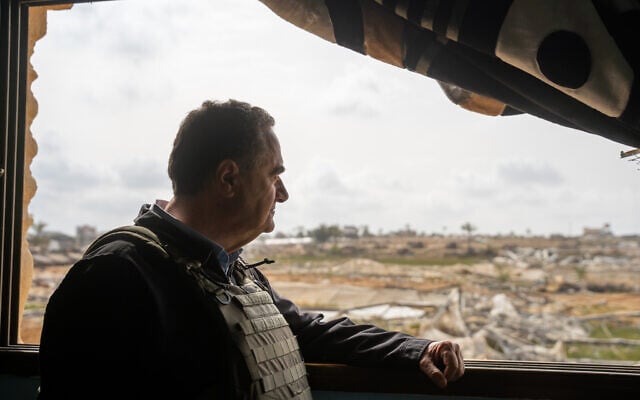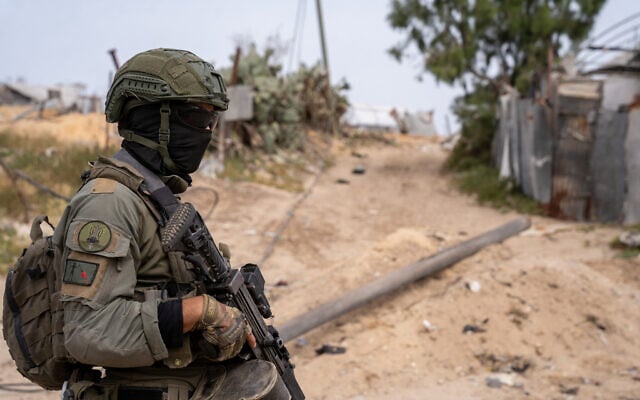Rafah, Gaza Strip – Little or no fighting took place in the Gaza Strip since the Israeli army resumed its offensive on the Hamas terrorist group several weeks ago.
Israeli defense forces have progressed in the south of the strip, capturing the so-called Morag corridor, located between the Palestinian cities of Rafah and Khan Younis; largely expanding its buffer area along the Gaza border; Make more than 1,000 air strikes on Hamas targets, eliminating more than 40 senior officials and intermediate level commanders; And located several new tunnels.
The current offensive aims to “increase pressure on Hamas to release hostages” and prepare the plan of the Israel plan to “defeat Hamas,” said Defense Minister Israel Katz on Wednesday during a visit to the Morag corridor, an area where the FDI had not previously worked.
Katz said that the FDIs produced “great achievements” during the recovery fights, in particular evacuating the civilian population to Rafah and surrounding the city.
But these “achievements” do not seem to affect Hamas for the moment.
The talks with the terrorist group to release the 59 hostages remaining still in captivity have apparently blocked, and at the same time, Hamas agents almost do not entirely engage the Israeli troops on the ground.

The Minister of Defense, Israel Katz, is seen in the Morag corridor area of the South Gaza Strip, between Rafah and Khan Younis, April 9, 2025. (Emanuel Fabian / Times of Israel)
The terrorist group also recruited more fighters and tried to restore its limited weapons caches. The IDF estimates that the terrorist group has some 20,000 active fighters, half of what it had before the war.
Israeli officials said that the country was willing to engage in talks at the end of the war in Gaza, but will insist to achieve its objectives – the return of all hostages, the disarmament of Hamas and other terrorist groups of Gaza, the exile of Hamas leaders and a new governance structure that does not understand Hamas.
And if the terrorist group continues to dig into its heels and refuses to respond to the requests of Israel, the FDIs possibly call a large number of reservists to “defeat Hamas,” said Katz.
“If Hamas continues its refusal and will not publish the hostages soon, the FDI will pass to intensive fights in all Gaza, until the hostages are released and Hamas is defeated,” he said.
Some military officials believe that Hamas will never surrender, no matter how fdi strikes him.
Katz said he was thinking that a new hostage agreement with Hamas was “more likely than before” because of the new FDI offensive, which he said was putting pressure on the terrorist group.

An IDF tank is seen in the Morag corridor area of the South Gaza Strip, between Rafah and Khan Younis, April 9, 2025. (Emanuel Fabian / Times of Israel)
“Move the population, capture the territory, the continuous humanitarian blockade, all these elements exert strong pressure on Hamas to release the hostages. I hope this pressure, alongside the powerful FDI activities, will work, and we will come back to the way to the release of the hostages,” he said.
Regarding the growing humanitarian crisis in Gaza, after Israel has ceased to allow the entry of aid, Katz said: “There is no shortage in Gaza, and there is no intention to reopen.”
Katz said that if a hostage agreement occurred, the current IDF offensive would stop “immediately”.
But he said that the soldiers were still preparing for “the big blow”, which would involve writing many reservists to defeat Hamas. “It will happen ultimately,” he said.
New corridor, extended buffer zone
Some 250,000 Palestinians – mainly from Rafah – have evacuated the Gaza areas declared by the FSAhal as combat zones since March 18, and among them are many terrorist agents who choose not to fight, according to military estimates.
The FDIs launched massive strikes in the south of Gaza before the troops of the 188th armored brigade and the Golani infantry brigade – operating under the 36th division – entered for the first time in the Morag corridor area.
The Morag corridor is expected to take place about 15 kilometers from the Israeli border community in Sufa on the coast of the band, parallel to the Philadelphi corridor in the border area of Egypt-Gaza, which is also controlled by the FDI.

TSAhal troops are seen in the Morag corridor area of the Southern Gaza Strip, between Rafah and Khan Younis, April 9, 2025. (Emanuel Fabian / Times of Israel)
Once the corridor is fully established, the FDI will actually cut Rafah from Khan Younis.
The army aims to operate within Rafah areas to defeat the forces of the remaining Hamas, despite six months ago that the Rafah brigade of the terrorist group had already been defeated.
So far, the FDI has located several Hamas tunnels in the region between Rafah and Khan Younis, as well as other terrorist infrastructure.
In total, the army estimates that it only destroyed 25% of Hamas tunnels throughout the band since the start of the war. He argues that the main objective was on Hamas attack tunnels and those used as command centers or for the manufacture of weapons – the majority of which were destroyed – rather than on the many tunnels that Hamas uses to move around the band.

A soldier from TDI is seen in the Morag corridor area of the Southern Gaza Strip, between Rafah and Khan Younis, April 9, 2025. (Emanuel Fabian / Times of Israel)
After the Hamas Rafah brigade has been defeated, the FDI buffer zone in the south of Gaza will extend from the Egyptian border to the outskirts of Khan Younis – about 5 kilometers – and includes the entire city of Rafah – about 20% of the band.
The IDF buffer area elsewhere on the border with Gaza also went from several hundred meters to around 2 kilometers in most regions.
In the midst of all new operations in Gaza in recent weeks, the FDI has reported only one incident of troops to the fire.
With 20,000 active agents and apparently no plan to go, it is unlikely that Hamas will be too weakened to hire FDI.
On the contrary, Hamas is preparing, just as the FDI is, for a much more important battle, which would put more than probably in danger the 24 remaining living hostages which are always detained by the terrorist group.


